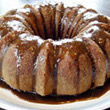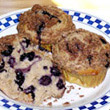Quick Bread Pointers
Additions and Substitutions
Quick bread recipes are fairly versatile: you can add and substitute ingredients with greater freedom than you can with most other baked goods. To lower the fat, you can substitute some of the oil with an equal amount of almost any fruit puree (applesauce, plum baby food, pumpkin puree, mashed bananas). You can add nuts and dried fruit as desired.
Dried Fruit
When you use dried fruit in a quick bread recipe, try soaking the fruit first: not only will this make the fruit moist and tender, but adding moisture to the fruit before stirring it into the batter will also preserve the moisture of the bread. Place the dried fruit in a heatproof bowl and pour just enough boiling water over it to cover. Let it soak for 15 minutes or so, then drain and add to the finished batter. For added flavor, soak fruit in hot apple or orange juice--or soak the fruit overnight in whiskey, rum or brandy. Don't sprinkle dried fruit on top of the quick bread before baking, as it will burn before the loaf is done.
Glazes
Add a finishing touch and a burst of flavor to finished quick breads by glazing them. Allow them to cool, and then make a simple mixture of confectioners' sugar and a little milk or fruit juice. Try orange and lemon juices, for their fragrant, tart zing; add curls of zest for extra color and flavor.
 |
Mixing the Batter
The secret to perfectly moist, tender quick bread is in the mixing: use a gentle touch. Combine the dry ingredients--flour, leavener, salt and spices--in a bowl: either sift them together or mix them thoroughly with a wire whisk. In another bowl, beat together the fat, sugar and eggs in the order the recipe advises. Stir any other ingredients (fruit puree, flavorings or extracts) into the wet ingredients. Only when each bowl of ingredients is mixed thoroughly should they be combined. When you are ready, pour the dry ingredients into the wet ones and fold them together gently. Do this part by hand rather than with a mixer. Add nuts and fruits; stir just until incorporated. Over-mixing will cause "tunnels"--holes where the air bubbles escaped--and will make the bread tough.
 |
Troubleshooting
Try these fixes to common problems:
- Bread sticks to pan Unless you're using high-quality nonstick metal or silicone baking pans, you should always grease the pans before you pour in the batter. The best thing to use for greasing the pan is shortening, because its melting point is higher than any other kind of fat, and therefore maintains a "shield" between the pan and the batter while the bread is baking. A high-quality cooking spray--one that won't bake on to your pans and discolor them--is also a fast, easy fix. You can also prevent sticking by removing the bread from the pan sooner: let the bread cool for at least twenty minutes in order to set (Bundt loaves should cool twice as long) before inverting the pan.
- There are big holes and "tunnels" in the bread, and/or the bread is tough These problems are usually caused by over-mixing. See above, Mixing the Batter, about mixing technique.
- There's a big crack down the middle of the quick bread loaf The crack on top happens when top of the loaf "sets" in the heat of the oven before the bread is finished rising. Don't worry--it's normal for quick breads. Drizzle the loaf with icing or dust with confectioners' sugar.
- My blueberry muffins look green! By reacting with the alkaline baking soda, the blueberries' pigments can turn green. Toss the berries with the flour mixture before combining the ingredients; the coating should help. If you're using frozen berries, don't thaw them before using them.
- The bread looks done on the outside but it's still raw in the middle This is one of the most common quick bread problems, and it can be caused by a few different factors. The oven temperature could be too high. (Invest in an oven thermometer: they're cheap and available at most supermarkets.)
- Try lowering the oven temperature and/or putting a loose tent of foil over the top of the bread so it won't burn before the middle has time to catch up.
- Another cause of the "raw center" problem: using a different pan that the recipe calls for. One of the nice things about quick breads is that you can use the same batter to make muffins, mini loaves, jumbo loaves, or rounds. But each size requires different baking times--and some require different baking temperatures. The larger and thicker the loaf, the longer it's going to take to bake. If you're using a different size pan than your recipe calls for, adjust the baking time accordingly and check the bread often.

Tidak ada komentar:
Posting Komentar